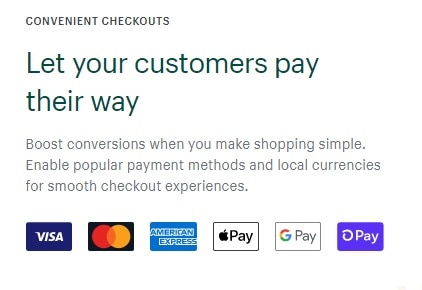How to Set Up an Online Store
- By Douglas Moore
- November 24, 2020

Table of Contents
So you’ve had a website for your business for a couple of years now, but it’s served as nothing more than an online “business card.” Thus far, it’s been a basic website with a bit of information about what you do, what you sell, and where people can find you. While this is the case for a lot of long-standing brick-and-mortar businesses, the bare truth is that the future of selling – or rather, a big chunk of it – is online.
Wrap your mind around this: even before the trying times of the coronavirus, in 2019 alone there were 1.92 billion digital buyers worldwide. When it comes to the US, 69% of Americans have shopped online at some point in their lives, and that percentage is rising every day. The projections for 2021 predict that the number of online shoppers will rise to an incredible 2.14 billion. Convinced yet? Good!
Now that we’ve decided that it’s time for you to start selling your products (or services) online, let’s get down into the nitty-gritty of starting an online store. We’ll take you through the process of how to start an online store on your existing website, as well as how to handle bookings, orders, and payments online. If you’re feeling intimidated, don’t! We’ll take it one step at a time, as we know this is your first step into the world of selling online.
How to Set Up an Online Store
The best way to set up an online store is by adding it to your existing website. Adding online shopping functionalities to your site will make the process of getting orders and getting paid much simpler. The easiest way to start a store on your website is by integrating an eCommerce platform. So first, let’s take a look at how you can do just that. But first…
A Word of Caution: Security
Before we get into the depths of starting an online store, it’s crucial to point out how important security is.
You want your client’s money – and eventually, your money – to be safe. You want sales made on your website to be secure. So before you set up an online shop on your website, you need to make sure that your website is secure. Online security 101 comes in the form of a website running over HTTPS rather than HTTP. If your website is running on HTTP, you should migrate it to HTTPS. It’s a lot more secure and an absolute must for online shops. Plus, it’s quite easy to do! You can get free SSL certificates as part of our web hosting plans.
Now that we got that little disclaimer out of the way, let’s get to it!
Step 1: Choose an eCommerce Platform to Integrate to Your Website
While you can also choose to sell your products from an existing eCommerce platform, it’s important to sell products directly from your website by integrating an eCommerce platform to your existing site.
Selling products directly from your website has several perks, like allowing existing customers to find you with ease. Basically, all they’ll have to do is type in your business’s name into Google or access your website directly (assuming they already know it). It also gives you more control over the branding, sales, and user experience – selling from your own website definitely adds a personal touch to the whole deal. Of course, there are also difficulties, like the fact that you’ll have to do the marketing yourself – but more on this later.
So – eCommerce platforms. eCommerce platforms are a type of software apps that help online businesses create shops to market, sell, and manage the sales of their products. They are also referred to as eCommerce website builders and shopping cart software. Integrating this sort of software to your website will help you centralize your business operations and make the sales process a whole lot easier.
Our Top Recommendations
There are several popular eCommerce platforms that you can choose from based on the scope of your online business, your budget, and your preferences. You can easily integrate these platforms into your website for a smooth online shopping experience. Our two top choices are WooCommerce and Shopify, so we’ll first take an in-depth look into their features, benefits, and drawbacks. Then, we’ll quickly go over some other eCommerce options you can consider.
The two best ways of doing this are either by using an eCommerce platform (Shopify) or an eCommerce plugin (WooCommerce). Which option is best for you depends on your budget, skill level, and the CMS you’re using. For instance, as you’ll see, WooCommerce is a great choice for people using WordPress. (The third option is building an eCommerce platform from scratch, but this is only viable for big businesses with lots of developers and a whole lot of cash at their disposal.)
Without further ado, let’s go over the best eCommerce platforms, along with their pros and cons, so that you can choose the best option for your site.
WooCommerce
WooCommerce is one of the best eCommerce plugins you will come across. It’s free (unless you upgrade), very versatile, and super easy to use. It’s specifically built for WordPress, a CMS used by nearly 40% of all websites, while 17.7% of WordPress websites also use WooCommerce. In a nutshell, WooCommerce has some great rep.
WooCommerce uses open-source software, which means that it’s being constantly updated and added onto to improve user experience. It also means that there’s a lot of options and possibilities for you to customize your WooCommerce shop as you wish. You can easily create custom extensions, or add existing extensions to your WooCommerce shop to have whatever functionalities you think will improve business.
We particularly recommend WooCommerce to small and mid-sized businesses. Although there’s a bit of a learning curve, this plugin can help you figure out the ins and outs of your shop. It also makes it easy to craft it just as you need it.

In terms of cost, using WooCommerce is technically free – however, you’ll still need to pay the annual fee for your domain name and pay for website hosting, such as our specialized WordPress hosting. Our affordable WordPress hosting plans will make website building as simple as possible, and security a done deal.
Some of the main features that WooCommerce offers are:
- Customizable design: There are thousands of free themes and storefront designs you can find in the WordPress library and customize to suit your website’s look. WooCommerce makes it easy to create a beautiful store with only a few clicks.
- Clean interface: WooCommerce is popular for its intuitive, clean interface which makes it quite easy to use. It’s also what makes it a great choice for beginners.
- Built-in tools and integrations: the base version of WooCommerce – before you add any extensions – already offers a lot of useful tools for building and maintaining an eCommerce store. You can showcase products your own way, handle bookings and subscriptions, use multiple payment methods, calculate shipping, get inventory management, geo-location support, and so on.
- A broad array of payment methods available: You can customize and optimize the WooCommerce checkout experience for your customers to include a variety of popular online payment methods. Offering multiple payment methods is important in order to increase your chances of making a sale! WooCommerce supports everything from credit cards and bank transactions, to payment facilitators like Stripe and PayPal.
- Thousands of free (and paid) extensions: You can choose from thousands of extensions to customize the functionality of your WooCommerce store. For instance, you can get a tax calculation tool and a tool to configure shipping for free or pay for a dynamic pricing extension.
- SEO boosting: WordPress is one of the best CMSs when it comes to building SEO. However, there are also great add-ons you can use to boost your SEO on WooCommerce.
Now that you’re familiar with some of the main features of WooCommerce, let’s look at its benefits and drawbacks.
Pros:
Customizability. As it’s a free, open-source plugin, WooCommerce is very easy to customize in order to suit the needs, design, and functionality of your online store. Although some extensions are paid, you can get most for free. It certainly comes with more free themes than Shopify.
Ease-of-use. If you’ve ever used WordPress, you know that installing a plugin is as simple as a single click. Plus, the intuitive user interface of WooCommerce makes it especially easy to build and customize your store.
Low starting cost. Technically, WooCommerce is free, so once you figure out hosting, you won’t need to worry about any additional payments – unless, of course, you want to purchase some premium extensions.
Cons:
May get a bit challenging for newbies. While the interface is quite intuitive, there’s a bit of a learning curve on how to best use WooCommerce if you’re a complete beginner.
Pricey extensions. If you want some of the best services that you can integrate with WooCommerce, you may need to pay for some pricey extension.
Be careful with new add-ons. As WooCommerce uses free, open-source software, anyone can pretty much create extensions for the plugin. So before you add a new extension, make sure it has good reviews that say it’s secure and bug-free.
The Verdict:
WooCommerce is a great choice for small to midsize businesses. It’s also a great place to start if you’re on a limited budget, as it has no costs other than what you’d pay for a great deal on WordPress hosting. If you want full control of your website, store, and shopping cart, the versatile, customizable features of WooCommerce make it an excellent choice.
Shopify
Shopify is a cloud-based SaaS (software as a service), and one of the most popular eCommerce platforms for online shopping. It’s quite easy to use, offers top-notch security, and can help you build and develop your online store however you like thanks to its many versatile features. In fact, their customizable themes and templates help them stand out with a sleek, modern design. Plus, the intuitive user interface will allow you to tweak the look to fit your brand.

Overall, Shopify comes with everything you’d need to sell from your website. In addition to building a shop, they can help you with marketing, sales, and shipment. The software prices begin at $29/month (but make sure to check current prices!). You can also use Shopify for your website hosting, or you can just use the Shopify eCommerce software and a separate host.
Some of the main features that Shopify offers are:
- Security: Shopify is PCI DSS compliant, which will keep your customers’ payments secure. It also ensures the security and privacy of your account data.
- Design: You can choose from lots of sleek, modern themes and templates for the design of your website and online shop.
- Hosting: You can also use Shopify as your hosting provider.
- 24/7 customer support: available through phone, email, or live chat.
- Free SSL certificates.
- Mobile-friendly website.
- SEO: This will help you boost your online visibility.
- A website builder: The easy-to-use, drag-and-drop website builder can help you refresh the overall look of your old website.
- Unmetered bandwidth, storage, and products.
- Multiple payment methods: this is quite important, as offering your customers multiple payment options will increase your chances of making a sale. A good rule of thumb is offering PayPal (or Stripe) and pairing it with the option to pay via credit card or debit card.

With the features in mind, let’s go over the pros and cons of using Shopify.
Pros:
Ease-of-use. One of the reasons Shopify is so popular is its ease-of-use. If you don’t feel very tech-savvy, you’ll nonetheless be able to figure out how to use their software soon enough. Plus, it comes with all the basic features that a starter shop would need.
Low starting cost. As the prices start at $29/month, starting your online shop with Shopify will be quite affordable.
Great support. For a beginner, having a constantly available support team can really help out.
Cons:
Per-sale transactions fees. Unless you’re using Shopify Payments (which is a bit buggy and not many people do), you’ll need to pay fees for each transaction which cost 0.5%, 1%, or 2% of the sale, depending on which Shopify plan you’re using.
Limited features. Although Shopify offers all of the basic features you’d need to start an online shop, it lacks advanced features that specific merchants and specific products may need. Especially as your business grows, you’ll see a rising need to purchase add-ons, which can get expensive over time.
The Verdict:
Shopify is a great option for beginners. It can help you create and manage your online shop with little to no experience. It’s also a good choice for large stores, but the cost of using it will rise over time. Additionally, if your product or service requires more advanced features for the shopping cart to work properly for the customers, you may end up spending money on costly add-ons.
Runner-Up: Weebly
There are a few more well-crafted eCommerce platforms that can help your online store take off, but our favorite by far is Weebly. Weebly is actually a website builder, which also offers you the possibility of building an eCommerce store. Keep in mind that being able to both build your website and build your store from one place can make things quite a bit easier. Weebly is very easy to use and affordable. We especially recommend it to small businesses.
We offer Weebly for free with any of our regular hosting plans. Here are some of its main features:
Weebly Features Overview:
Weebly is famous for its ease-of-use. The drag-and-drop website building interface also applies to the Weebly eCommerce store builder. In other words, you can just point and click to design your store. Additionally, the templates that Weebly offers are quite clean, modern, and attractive. They may be simpler than, say, Shopify’s, but sometimes, less is more.
As Weebly is a website builder that includes an eCommerce builder, it has fewer tools and features than the eCommerce platforms we talked about above. That being said, however, Weebly offers all the main, basic tools and functionalities you’ll need to set up your online store. And it executes them quite well, at that. It’s also simpler to set up and use than eCommerce platforms like Shopify.
Weebly will ensure secure financial transactions on your eCommerce store. It also comes with the main functions you’d want for both design (hundreds of beautiful, free eCommerce themes) and functionality (various SEO tools, shipment methods, and lots of payment options – including PayPal and Stripe).
It’s also quite mobile-friendly, which is a great way to win over some smartphone shoppers.
Another awesome feature of Weebly is that unlike Shopify, some of its plans don’t include transaction fees per purchase (the Business plan, to be exact). Overall, Weebly is a lot more affordable than other eCommerce platforms, as the priciest plan they offer is $25/month.
The Bottom Line:
Shopify and WooCommerce are a great choice for small to large businesses, and businesses looking to expand. Shopify is more user-friendly and a great choice for less tech-savvy people, so it’s a good option if you’re a beginner. WooCommerce is a better choice for people that already have some website building experience, as it offers quite a few advanced features via extensions. It’s also an ideal option for those looking to have complete creative and functional control over their eCommerce store.
Weebly is a great choice for small stores and starters who are on a more limited budget. It’s also a Godsend to tech beginners, as it’s incredibly easy to use.
Step 2: Choose and Customize a Template
Once you’ve selected an eCommerce platform that suits your budget, needs, and business, it’s time to pick a theme or template which reflects you and your product. Then, you should customize your theme/template to reflect your business.
Overall, the popular design type for websites has shifted towards clean, simple, elegant looks. That means that your website shouldn’t contain any pages that are overwhelming and crowded with content or too many products. This won’t look professional and will be too distracting for potential customers.
You can customize your website from any page builder, and you can customize your store from the admin tool of the eCommerce platform you’ve chosen.
When it comes to customizing, here are a couple of tips:
Tips for Customizing Your Online Store
- Choose a color scheme and pattern that reflects your logo, your product, and your customer base. As you can imagine, a store that sells auto parts and a store that sells handicrafts are likely to have different customer bases and thus require different color patterns and branding.
- Customize your text font and size to create continuity throughout the pages of your website.
- Add images that will attract customers to your site and your products. You can go over our resourceful image optimization guide to learn more about how to prepare images for your website.
- Embed social media to your website, or in other words, offer the option of redirecting people to your business’s Facebook, Instagram, and Twitter accounts. If they end up following you, your store will get better exposure.
- Check out the various features and functionalities that are offered with the store or website builder. WordPress, for instance, has thousands of plugins that can help you optimize the functionality of your website.
Step 3: Choose Payment Methods
An important part of setting up an online store is choosing what online payment methods you will accept. It’s always a good idea to include multiple payment methods, as not all of your potential clients will have the same payment tools at their disposal. This will keep your customers happy and frustration-free.
Combining Payment Options
A good rule of thumb is having a merchant of record that will process payments from credit cards and debit cards. This will allow some users to pay with credit cards, and others to pay directly from their PayPal account.
Luckily, all of the eCommerce platforms we recommended simplify this process of choosing payment methods by directly connecting you to various payment options through their store builder tools. Shopify and BigCommerce offer by far the most payment methods. Keep in mind, however, that if you’re just starting out, you probably won’t need every method imaginable available on your site. What is important is finding out what the preferred method of your niche, target audience is, and making sure it’s available in your store.
We also recommend that you check out our guide on how to get paid online, where you can get a clear idea of how to choose payment methods, how to keep customers from abandoning their cart, how to make your checkout page as appealing as possible, and how to maximize your chances of making a sale.
Step 4: Prepare Your Products and Add Them to the Shop
You know how the first rule of roadside produce sales is putting the most attractive produce on top? Because those crops are the money crops? Or how a lot of cake shops don’t actually have edible cakes in their store windows, but rather cake stand-ins that just look delicious? That’s because, in shopping, sight is the one sense that we rely on the most and use to instinctively judge things.
In fact, studies have shown that images are the most important part of online shopping.
Take Good Photos
To do your products justice, you need to take good photos of your products.
Here are a couple of tips you can follow to end up with attractive, appealing images of your products:
- Make sure the images are high-quality. If you have a smartphone with a really nice camera, or you have a professional/semi-professional digital camera, take photos of your products using the best possible quality. Avoid grainy or small images. Once you’ve taken the best photos, you can optimize them for better web performance. Images that look bad will chase potential clients away!
- Make the product look good. You may wish to choose an elegant background that isn’t overcrowded and allows the product to pop out. You should also consider taking multiple photos of each product and making them available in the shop so that the customers can see it from multiple angles.
- Offer a zoom feature. The shop builders usually provide this function. Adding a zoom feature allows customers to get a better look at the product.
- Where applicable, provide product variety. If you’re selling the same product in several different colors and styles, make them readily available for the shopper to view.
Prepare Great Product Descriptions
Product descriptions are the second stop for the shopper – the first, of course, being the image. It’s important to have great – not good – product descriptions that will familiarize your customers with the product without burdening them with complex vocabulary, long sentences, unnecessary information, and fluff. Also, definitely, definitely avoid cliches and overstatements.
To write a great product description, make sure to include details that your customer cares about, like the dimensions, weight, material, design, warranty, color options, and care instructions of the product. So it’s not that you shouldn’t include details – you just shouldn’t include details no one cares about.
Overall, you need to present the main features of your product and how they would benefit the user. We also recommend that you do your homework by doing SEO (Search Engine Optimization) research before writing the product descriptions to find out which words and phrases are most popular among internet users Googling products like yours. Adding those sought-after words to the product description can help you reach customers through search engines like Google or Bing, as well.
Create Product Categories
An optional third step is creating product categories. This is a good idea if you’re selling a variety of products. So if you’re selling sportswear, for instance, you’d have a section for men, a section for women, a section for tops, a section for bottoms, and so on.
You can also include filtering tools to your website that will help customers find the right product based on their unique specifications. These come quite in handy, as it increases the chances of a potential customer finding exactly what they want. Some parameters you can include in these filters are product price, size, in the case of clothes, gender, and so on.
You can also greet the customers entering your store with a couple of featured products, just to give them an idea what you’re all about.
Add Products to Your Shop
Once you’ve finished all the above work, you’re ready to add products to your shop! The store builder that accompanies your eCommerce platform of choice will make the process of adding products, descriptions, images, and prices simple for you.
Step 5: Manage Shipping
This step is only applicable to businesses that sell physical goods online. If you’re selling digital goods, shipment – clearly – isn’t something you need to worry about.
So you have started your online store, set up payment methods, prepared your products beautifully, and added them to your store. The last step you need to worry about is shipment. There are a couple of parts of managing shipment – you need to decide which geographic regions you’re sending shipments to, what sort of shipment do you offer to clients, and which shipping service you use.
Before doing any of this, however, make sure to specify the exact origin location of your products, especially if it’s a different place from your office. This will help you get the correct taxes and shipping rates.
Where Will You Ship Your Products?
Think over where you’d like to sell your products. If you’ve just started selling online, this is your first time dealing with product shipment, or you’re on a tight budget, it may be a good idea to limit sales – at least while things take off – to nearby zones and locations.
The shipping rates and taxes will change depending on the regions, countries, and states you’re sending your products to. If you’re based in the US, for instance, it will cost more to send things in other countries or further-away states than zones near your origin location.
Using the store builder provided by an eCommerce platform, you can determine and announce which locations you ship to, as well as what the shipping rates are for different locations. This will allow you to offer free shipping within your state, but charge a shipping fee to other states, for instance.
Which Shipping Method Is Right For You?
The next part you need to decide on is how to deal with shipping money-wise. Here are the main types of shipping you can offer your customers:
- Free shipping: free shipping is a great selling point, but it only makes sense if you can afford it, for one, and still be able to turn a profit, for another. One way you can do this is by offering free shipping for orders above a certain order amount. So like you wouldn’t offer it for a $50 purchase, but you would for anything above $100.
- Shipping flat rate: if a lot of your products are similar in price and weight, you could just offer a flat shipping rate. Eventually, the cost will balance out (the lower cost of nearer states and the higher cost of shipping to farther states).
- Real-time shipping quotes: you can also decide on the shipping rate per-purchase based on the amount of money in question, the size and weight of the product, the distance of the buyer, and so on.
Which Shipping Service Is Right for You?
Lastly, you’ll need to decide which shipping service to use. Some of the most popular shipping services are UPS/ USPS, FedEx, and Canada Post. It’s important to choose a courier that you trust and won’t damage the product.
You can also alternate between these couriers depending on when your customers want their product. If they want their product sooner, for instance, they can pay an additional fee for FedEx fast delivery and so on.
Some eCommerce platforms, such as Shopify, may provide you with discounts to great couriers, as they have business partnerships.
A Few Words Before You Go…
Voila! You’re all set to go. All that’s left is previewing your shop before publishing it online. You can also play with some additional customization settings, like currencies, languages, and contact details. Make sure to create a nice About page so that your customers will know where they can find you and who you are!
View Related Articles

All About the .tech Domain Extension
Now here we have an attractive gTLD (generic top-level domain) for all of you that are somehow part of the tech industry. We are talking about the .tech TLD that was introduced relatively recently, and has gained a lot of popularity among this niche.

Is Domain Privacy Worth It?
Normally, once a domain is registered, the information of the owner – your information – is listed in the WHOIS database. However, not everyone likes to have their information available to the public, as this can have some downsides – like receiving spam.

All About the .one Domain Extension
This domain extension is great since it’s easy to remember, and everyone wants a catchy domain name. From the visual perspective, the .one domain extension contains 3 letters, just like .com, .org, or .net, and it has the added benefit of being a dictionary word.